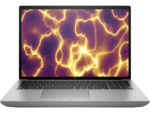HP ZBook Fury 16 G11
Specifications

Primary Camera: 5 MPix
Price comparison
Average of 3 scores (from 2 reviews)
Reviews for the HP ZBook Fury 16 G11
The ZBook Fury 16 series has been updated with new Raptor Lake-HX processor options for faster performance. The difference, however, is smaller than we would like to be mostly unnoticeable for most scenarios.
Source: PC Mag

We admire Dell's Precision 5690 as a potent but relatively portable mobile workstation, but when even that machine's extreme power isn't enough, the ZBook Fury 16 G11 stands alone. If you need the raw horsepower, memory, and storage to justify its cost—or more likely, make its cost the smallest part of a project's payables—it's a simply awesome Editors' Choice award winner.
Single Review, online available, Medium, Date: 08/26/2024
Rating: Total score: 80%
Foreign Reviews
Source: Tweakers
 NL→EN
NL→ENUser Review, online available, Very Short, Date: 01/23/2025
Rating: Total score: 60%
Comment
Model:
The HP ZBook Fury 16 G11 retains the same chassis design as its predecessor, with the key distinguishing feature being the new Co-Pilot key on the keyboard. This model continues to offer a premium, robust design tailored for high-performance tasks, suitable for professionals who need a reliable workstation laptop. The display options are a standout feature, with five available configurations. This model comes with a 3840 x 2400 resolution, 500 nits brightness, 120 Hz refresh rate, and 100% DCI-P3 colour coverage. This display offers exceptional visual quality, consistent with the ZBook Fury 16 G10. However, for outdoor use, the 1000-nit option is recommended, though it is paired with Sure View technology, which limits viewing angles and makes it harder to share the screen. Alternatively, the OLED option delivers superior black levels for digital artists and multimedia editors but has a glossy overlay and a lower 60 Hz refresh rate, which may not be ideal for everyone. The display is well-calibrated, offering minimal deltaE values for grayscale and colour, ensuring a precise visual experience for most users.
In terms of performance, the ZBook Fury 16 G11 is powered by the Intel Core i9-14900HX processor. While this chip offers slightly improved Turbo Boost speeds compared to the previous generation Core i9-13950HX, the performance gains are modest—only around 10 to 15 percent, with throttling further reducing overall performance. The Core i9-14900HX utilizes the same architecture as its predecessor, essentially making it a rebrand of last year’s model. While the Lenovo Legion 9 16IRX9, equipped with the same processor, performs up to 20% faster due to its superior cooling solution, the ZBook Fury 16 G11's performance is largely in line with its predecessor. The maximum RAM speed is capped at 4000 MT/s when configured with 128 GB of memory due to SODIMM limitations, although the system supports both ECC and non-ECC RAM. Users can expect the same performance as last year’s ZBook Fury 16 G10 in everyday tasks.
On the graphics front, the ZBook Fury 16 G11 is equipped with the RTX 3500 Ada, which offers performance around 20 to 30 percent slower than the more powerful RTX 5000 Ada. Since Nvidia has not introduced a new generation of mobile GPUs, the ZBook Fury 16 G11 continues to use last year’s GPU options without any significant improvements. In terms of battery life, specific details are not provided, but the ZBook Fury 16 G11 is built to support extended work sessions, typical for mobile workstations. Overall, this laptop offers solid performance for professional users, but those expecting significant gains in processor and GPU performance may be disappointed by the incremental upgrades over the previous generation. Nevertheless, its robust design, high-quality display options, and support for large memory configurations make it a solid choice for demanding tasks.
Hands-on article by Jagadisa Rajarathnam
NVIDIA RTX 3500 Ada Generation Laptop: A higher-end professional graphics card for use in laptops that sports 5,120 CUDA cores and 12 GB of ECC GDDR6 VRAM. Brought into existence in 2023, this graphics adapter leverages TSMC's 5 nm (4N) process and Nvidia's Ada Lovelace architecture; hardware-wise, the RTX 3500 is a cut-down GeForce RTX 4070 (Desktop), as far as we can tell. Consequently, it makes use of the same AD104 chip and will have little difficulty running triple-A games at QHD 1440p. The Nvidia-recommended TGP range for the card is fairly wide at 60 W to 140 W leading to noticeable performance differences between different systems powered by what is supposed to be the same graphics card.
These graphics cards are able to play the latest and most demanding games in high resolutions and full detail settings with enabled Anti-Aliasing.
» Further information can be found in our Comparison of Mobile Graphics Cards and the corresponding Benchmark List.
i9-14900HX: High-end mobile hybrid processor based on the Raptor Lake architecture with 24 cores and 32 threads. Clocks at a maximum of 5.8 GHz (P cores).» Further information can be found in our Comparison of Mobile Processsors.



